BUS301: Performance Measurement Comparison: Service vs. Manufacturing
VerifiedAdded on 2023/01/12
|6
|1484
|59
Report
AI Summary
This report critically discusses the differences in performance measurement between service and manufacturing industries. It begins with an introduction to performance management and highlights key performance indicators (KPIs) relevant to both sectors, using Barclays Plc and Associated British Foods as illustrative examples. The main body delves into KPIs specific to the service and manufacturing industries, addressing aspects like cost management, customer satisfaction, employee engagement, delivery, waste management, and quality control. The report then examines the challenges unique to measuring performance in the service industry, such as perishability, simultaneity, intangibility, and heterogeneity. Furthermore, it differentiates between financial factors (profits, revenue, cost) and non-financial factors (employee engagement and satisfaction) within the performance management framework. The report concludes by emphasizing the importance of considering various factors to improve business performance and achieve sustainability, offering suggestions for continuous improvement based on key indicators. The report is supported by relevant academic references.

Performance
Management
Management
Paraphrase This Document
Need a fresh take? Get an instant paraphrase of this document with our AI Paraphraser
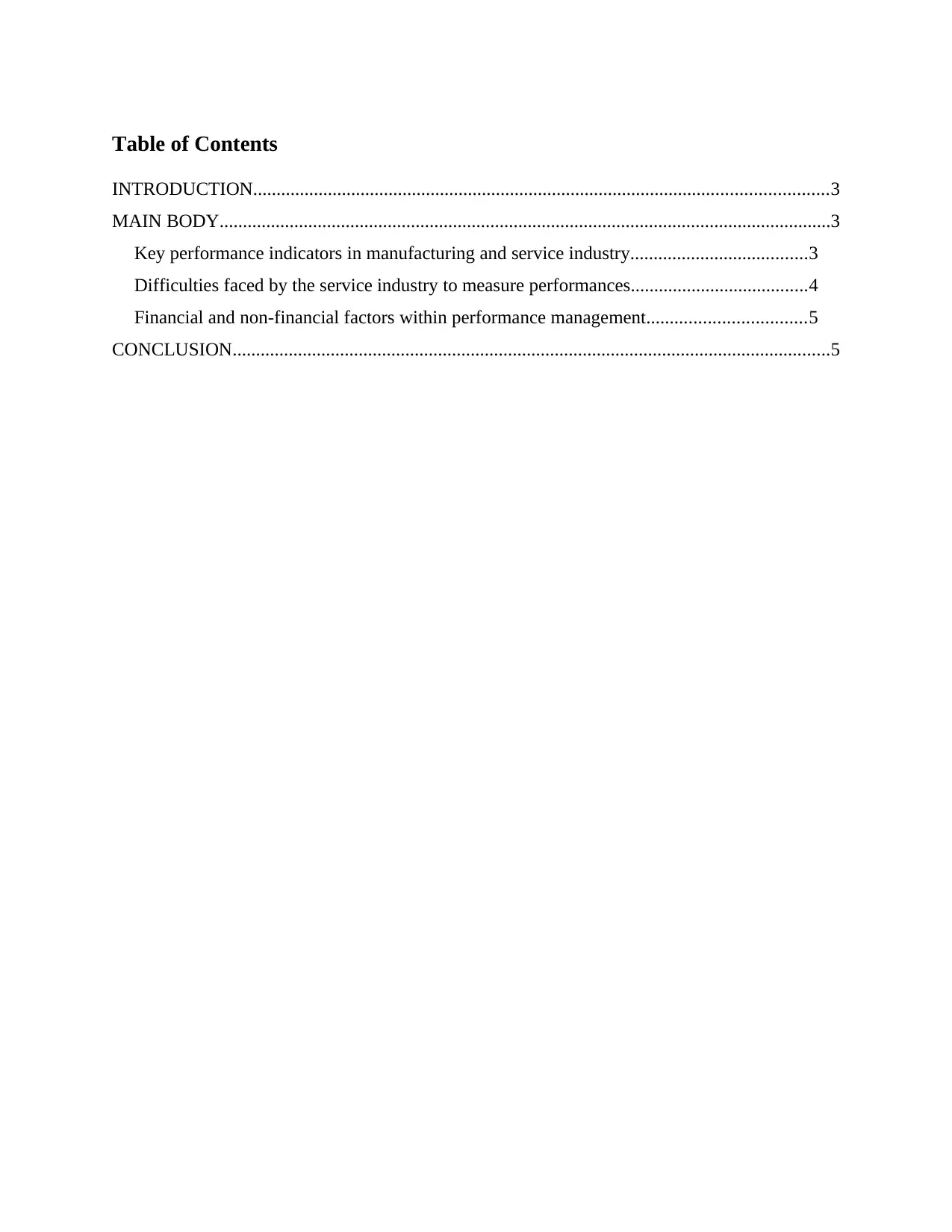
Table of Contents
INTRODUCTION...........................................................................................................................3
MAIN BODY...................................................................................................................................3
Key performance indicators in manufacturing and service industry......................................3
Difficulties faced by the service industry to measure performances......................................4
Financial and non-financial factors within performance management..................................5
CONCLUSION................................................................................................................................5
INTRODUCTION...........................................................................................................................3
MAIN BODY...................................................................................................................................3
Key performance indicators in manufacturing and service industry......................................3
Difficulties faced by the service industry to measure performances......................................4
Financial and non-financial factors within performance management..................................5
CONCLUSION................................................................................................................................5
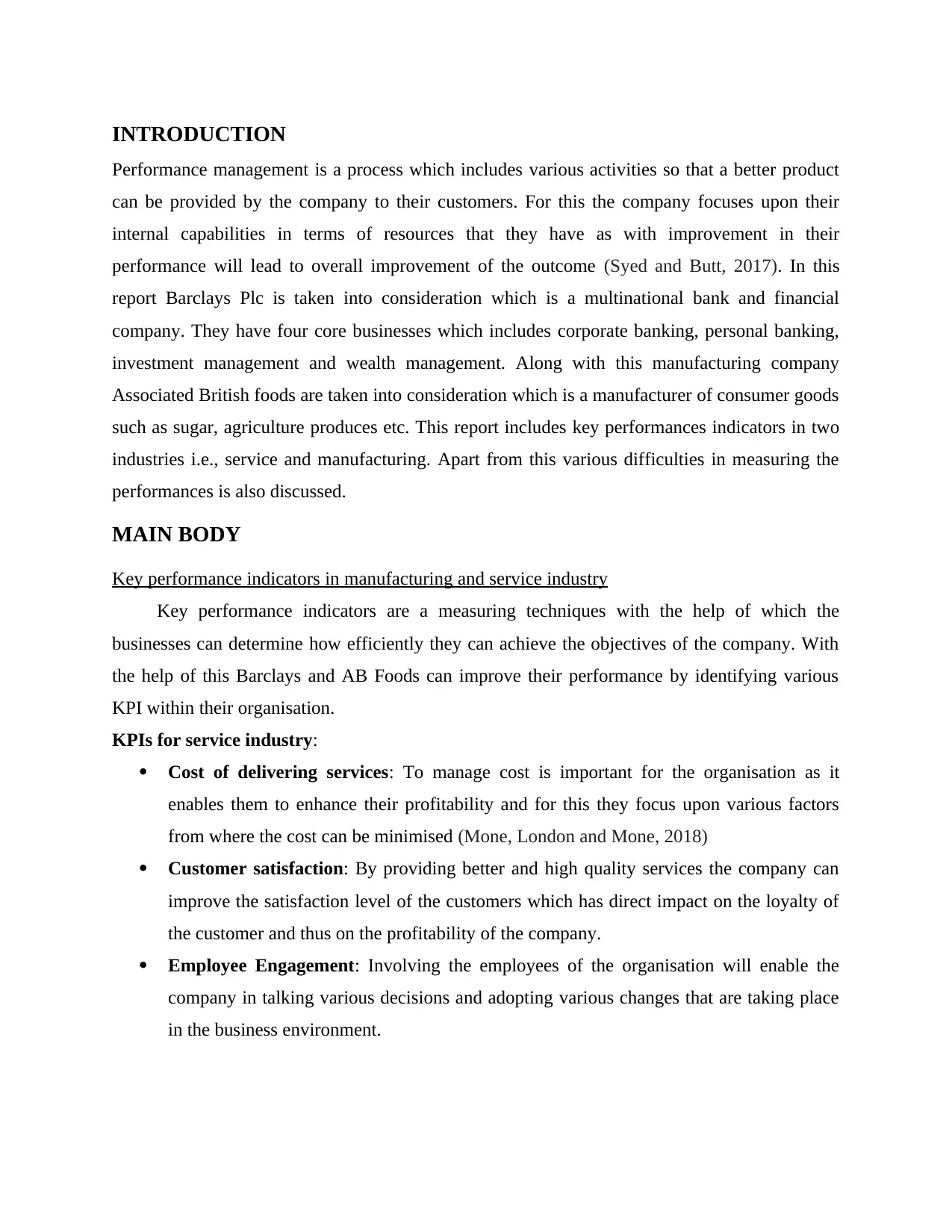
INTRODUCTION
Performance management is a process which includes various activities so that a better product
can be provided by the company to their customers. For this the company focuses upon their
internal capabilities in terms of resources that they have as with improvement in their
performance will lead to overall improvement of the outcome (Syed and Butt, 2017). In this
report Barclays Plc is taken into consideration which is a multinational bank and financial
company. They have four core businesses which includes corporate banking, personal banking,
investment management and wealth management. Along with this manufacturing company
Associated British foods are taken into consideration which is a manufacturer of consumer goods
such as sugar, agriculture produces etc. This report includes key performances indicators in two
industries i.e., service and manufacturing. Apart from this various difficulties in measuring the
performances is also discussed.
MAIN BODY
Key performance indicators in manufacturing and service industry
Key performance indicators are a measuring techniques with the help of which the
businesses can determine how efficiently they can achieve the objectives of the company. With
the help of this Barclays and AB Foods can improve their performance by identifying various
KPI within their organisation.
KPIs for service industry:
Cost of delivering services: To manage cost is important for the organisation as it
enables them to enhance their profitability and for this they focus upon various factors
from where the cost can be minimised (Mone, London and Mone, 2018)
Customer satisfaction: By providing better and high quality services the company can
improve the satisfaction level of the customers which has direct impact on the loyalty of
the customer and thus on the profitability of the company.
Employee Engagement: Involving the employees of the organisation will enable the
company in talking various decisions and adopting various changes that are taking place
in the business environment.
Performance management is a process which includes various activities so that a better product
can be provided by the company to their customers. For this the company focuses upon their
internal capabilities in terms of resources that they have as with improvement in their
performance will lead to overall improvement of the outcome (Syed and Butt, 2017). In this
report Barclays Plc is taken into consideration which is a multinational bank and financial
company. They have four core businesses which includes corporate banking, personal banking,
investment management and wealth management. Along with this manufacturing company
Associated British foods are taken into consideration which is a manufacturer of consumer goods
such as sugar, agriculture produces etc. This report includes key performances indicators in two
industries i.e., service and manufacturing. Apart from this various difficulties in measuring the
performances is also discussed.
MAIN BODY
Key performance indicators in manufacturing and service industry
Key performance indicators are a measuring techniques with the help of which the
businesses can determine how efficiently they can achieve the objectives of the company. With
the help of this Barclays and AB Foods can improve their performance by identifying various
KPI within their organisation.
KPIs for service industry:
Cost of delivering services: To manage cost is important for the organisation as it
enables them to enhance their profitability and for this they focus upon various factors
from where the cost can be minimised (Mone, London and Mone, 2018)
Customer satisfaction: By providing better and high quality services the company can
improve the satisfaction level of the customers which has direct impact on the loyalty of
the customer and thus on the profitability of the company.
Employee Engagement: Involving the employees of the organisation will enable the
company in talking various decisions and adopting various changes that are taking place
in the business environment.
⊘ This is a preview!⊘
Do you want full access?
Subscribe today to unlock all pages.

Trusted by 1+ million students worldwide
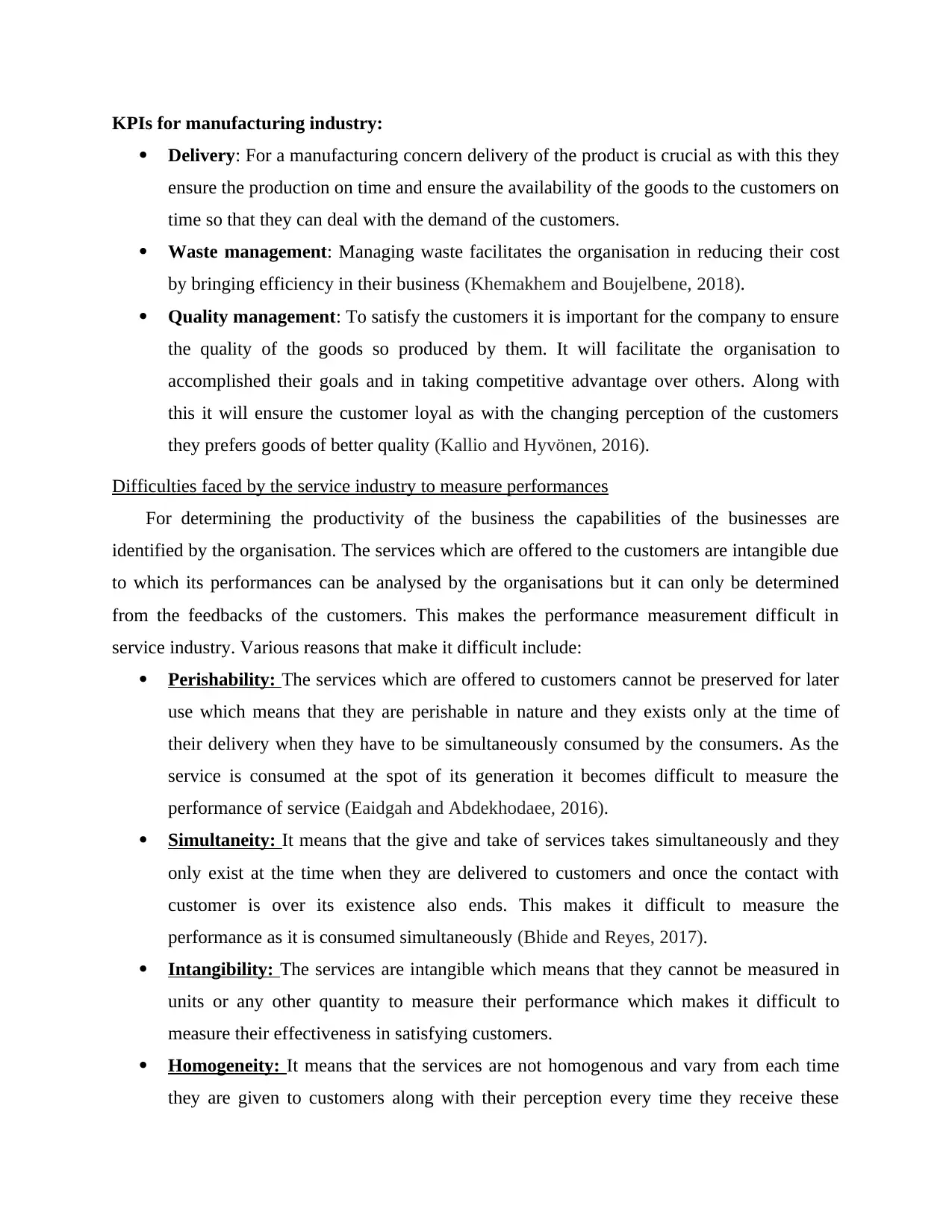
KPIs for manufacturing industry:
Delivery: For a manufacturing concern delivery of the product is crucial as with this they
ensure the production on time and ensure the availability of the goods to the customers on
time so that they can deal with the demand of the customers.
Waste management: Managing waste facilitates the organisation in reducing their cost
by bringing efficiency in their business (Khemakhem and Boujelbene, 2018).
Quality management: To satisfy the customers it is important for the company to ensure
the quality of the goods so produced by them. It will facilitate the organisation to
accomplished their goals and in taking competitive advantage over others. Along with
this it will ensure the customer loyal as with the changing perception of the customers
they prefers goods of better quality (Kallio and Hyvönen, 2016).
Difficulties faced by the service industry to measure performances
For determining the productivity of the business the capabilities of the businesses are
identified by the organisation. The services which are offered to the customers are intangible due
to which its performances can be analysed by the organisations but it can only be determined
from the feedbacks of the customers. This makes the performance measurement difficult in
service industry. Various reasons that make it difficult include:
Perishability: The services which are offered to customers cannot be preserved for later
use which means that they are perishable in nature and they exists only at the time of
their delivery when they have to be simultaneously consumed by the consumers. As the
service is consumed at the spot of its generation it becomes difficult to measure the
performance of service (Eaidgah and Abdekhodaee, 2016).
Simultaneity: It means that the give and take of services takes simultaneously and they
only exist at the time when they are delivered to customers and once the contact with
customer is over its existence also ends. This makes it difficult to measure the
performance as it is consumed simultaneously (Bhide and Reyes, 2017).
Intangibility: The services are intangible which means that they cannot be measured in
units or any other quantity to measure their performance which makes it difficult to
measure their effectiveness in satisfying customers.
Homogeneity: It means that the services are not homogenous and vary from each time
they are given to customers along with their perception every time they receive these
Delivery: For a manufacturing concern delivery of the product is crucial as with this they
ensure the production on time and ensure the availability of the goods to the customers on
time so that they can deal with the demand of the customers.
Waste management: Managing waste facilitates the organisation in reducing their cost
by bringing efficiency in their business (Khemakhem and Boujelbene, 2018).
Quality management: To satisfy the customers it is important for the company to ensure
the quality of the goods so produced by them. It will facilitate the organisation to
accomplished their goals and in taking competitive advantage over others. Along with
this it will ensure the customer loyal as with the changing perception of the customers
they prefers goods of better quality (Kallio and Hyvönen, 2016).
Difficulties faced by the service industry to measure performances
For determining the productivity of the business the capabilities of the businesses are
identified by the organisation. The services which are offered to the customers are intangible due
to which its performances can be analysed by the organisations but it can only be determined
from the feedbacks of the customers. This makes the performance measurement difficult in
service industry. Various reasons that make it difficult include:
Perishability: The services which are offered to customers cannot be preserved for later
use which means that they are perishable in nature and they exists only at the time of
their delivery when they have to be simultaneously consumed by the consumers. As the
service is consumed at the spot of its generation it becomes difficult to measure the
performance of service (Eaidgah and Abdekhodaee, 2016).
Simultaneity: It means that the give and take of services takes simultaneously and they
only exist at the time when they are delivered to customers and once the contact with
customer is over its existence also ends. This makes it difficult to measure the
performance as it is consumed simultaneously (Bhide and Reyes, 2017).
Intangibility: The services are intangible which means that they cannot be measured in
units or any other quantity to measure their performance which makes it difficult to
measure their effectiveness in satisfying customers.
Homogeneity: It means that the services are not homogenous and vary from each time
they are given to customers along with their perception every time they receive these
Paraphrase This Document
Need a fresh take? Get an instant paraphrase of this document with our AI Paraphraser
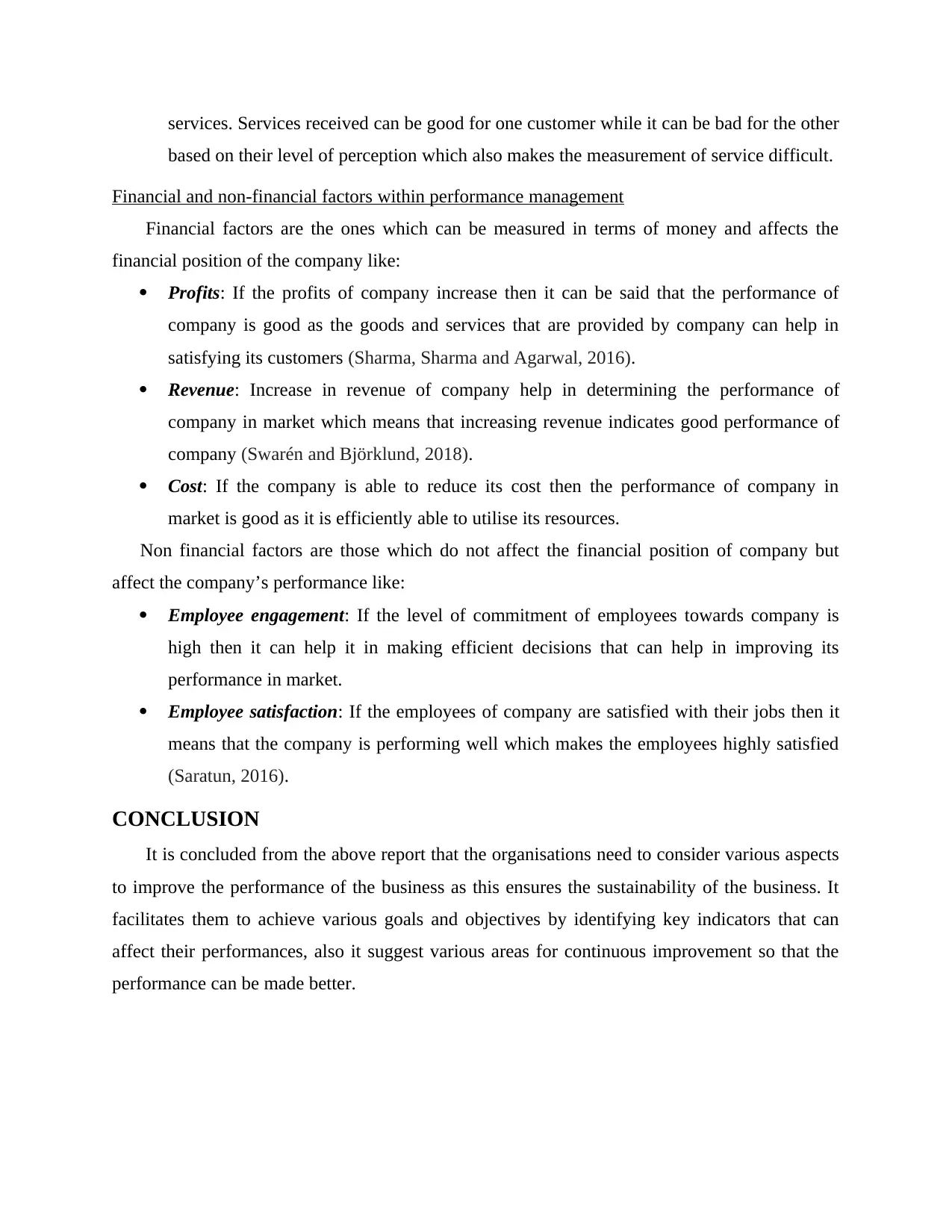
services. Services received can be good for one customer while it can be bad for the other
based on their level of perception which also makes the measurement of service difficult.
Financial and non-financial factors within performance management
Financial factors are the ones which can be measured in terms of money and affects the
financial position of the company like:
Profits: If the profits of company increase then it can be said that the performance of
company is good as the goods and services that are provided by company can help in
satisfying its customers (Sharma, Sharma and Agarwal, 2016).
Revenue: Increase in revenue of company help in determining the performance of
company in market which means that increasing revenue indicates good performance of
company (Swarén and Björklund, 2018).
Cost: If the company is able to reduce its cost then the performance of company in
market is good as it is efficiently able to utilise its resources.
Non financial factors are those which do not affect the financial position of company but
affect the company’s performance like:
Employee engagement: If the level of commitment of employees towards company is
high then it can help it in making efficient decisions that can help in improving its
performance in market.
Employee satisfaction: If the employees of company are satisfied with their jobs then it
means that the company is performing well which makes the employees highly satisfied
(Saratun, 2016).
CONCLUSION
It is concluded from the above report that the organisations need to consider various aspects
to improve the performance of the business as this ensures the sustainability of the business. It
facilitates them to achieve various goals and objectives by identifying key indicators that can
affect their performances, also it suggest various areas for continuous improvement so that the
performance can be made better.
based on their level of perception which also makes the measurement of service difficult.
Financial and non-financial factors within performance management
Financial factors are the ones which can be measured in terms of money and affects the
financial position of the company like:
Profits: If the profits of company increase then it can be said that the performance of
company is good as the goods and services that are provided by company can help in
satisfying its customers (Sharma, Sharma and Agarwal, 2016).
Revenue: Increase in revenue of company help in determining the performance of
company in market which means that increasing revenue indicates good performance of
company (Swarén and Björklund, 2018).
Cost: If the company is able to reduce its cost then the performance of company in
market is good as it is efficiently able to utilise its resources.
Non financial factors are those which do not affect the financial position of company but
affect the company’s performance like:
Employee engagement: If the level of commitment of employees towards company is
high then it can help it in making efficient decisions that can help in improving its
performance in market.
Employee satisfaction: If the employees of company are satisfied with their jobs then it
means that the company is performing well which makes the employees highly satisfied
(Saratun, 2016).
CONCLUSION
It is concluded from the above report that the organisations need to consider various aspects
to improve the performance of the business as this ensures the sustainability of the business. It
facilitates them to achieve various goals and objectives by identifying key indicators that can
affect their performances, also it suggest various areas for continuous improvement so that the
performance can be made better.
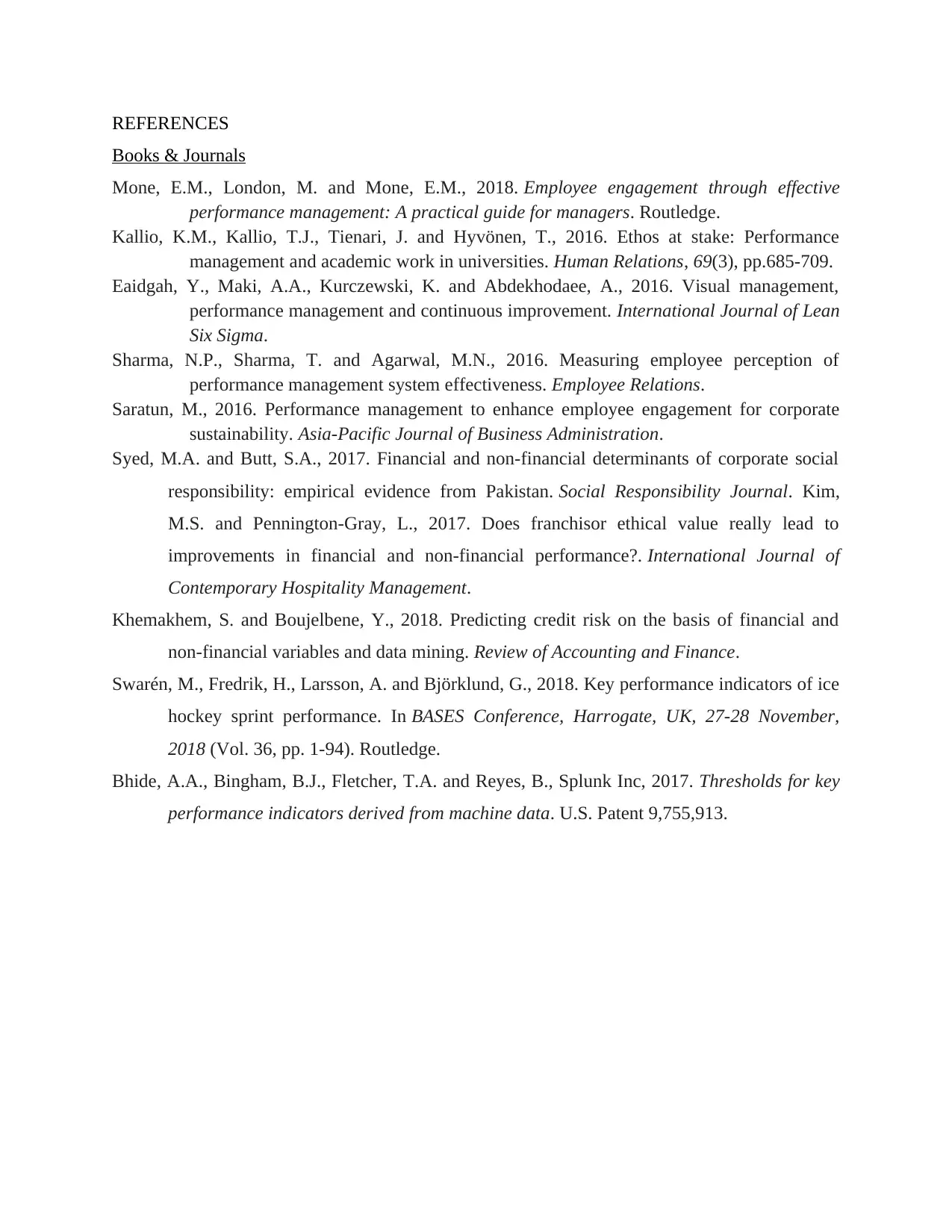
REFERENCES
Books & Journals
Mone, E.M., London, M. and Mone, E.M., 2018. Employee engagement through effective
performance management: A practical guide for managers. Routledge.
Kallio, K.M., Kallio, T.J., Tienari, J. and Hyvönen, T., 2016. Ethos at stake: Performance
management and academic work in universities. Human Relations, 69(3), pp.685-709.
Eaidgah, Y., Maki, A.A., Kurczewski, K. and Abdekhodaee, A., 2016. Visual management,
performance management and continuous improvement. International Journal of Lean
Six Sigma.
Sharma, N.P., Sharma, T. and Agarwal, M.N., 2016. Measuring employee perception of
performance management system effectiveness. Employee Relations.
Saratun, M., 2016. Performance management to enhance employee engagement for corporate
sustainability. Asia-Pacific Journal of Business Administration.
Syed, M.A. and Butt, S.A., 2017. Financial and non-financial determinants of corporate social
responsibility: empirical evidence from Pakistan. Social Responsibility Journal. Kim,
M.S. and Pennington-Gray, L., 2017. Does franchisor ethical value really lead to
improvements in financial and non-financial performance?. International Journal of
Contemporary Hospitality Management.
Khemakhem, S. and Boujelbene, Y., 2018. Predicting credit risk on the basis of financial and
non-financial variables and data mining. Review of Accounting and Finance.
Swarén, M., Fredrik, H., Larsson, A. and Björklund, G., 2018. Key performance indicators of ice
hockey sprint performance. In BASES Conference, Harrogate, UK, 27-28 November,
2018 (Vol. 36, pp. 1-94). Routledge.
Bhide, A.A., Bingham, B.J., Fletcher, T.A. and Reyes, B., Splunk Inc, 2017. Thresholds for key
performance indicators derived from machine data. U.S. Patent 9,755,913.
Books & Journals
Mone, E.M., London, M. and Mone, E.M., 2018. Employee engagement through effective
performance management: A practical guide for managers. Routledge.
Kallio, K.M., Kallio, T.J., Tienari, J. and Hyvönen, T., 2016. Ethos at stake: Performance
management and academic work in universities. Human Relations, 69(3), pp.685-709.
Eaidgah, Y., Maki, A.A., Kurczewski, K. and Abdekhodaee, A., 2016. Visual management,
performance management and continuous improvement. International Journal of Lean
Six Sigma.
Sharma, N.P., Sharma, T. and Agarwal, M.N., 2016. Measuring employee perception of
performance management system effectiveness. Employee Relations.
Saratun, M., 2016. Performance management to enhance employee engagement for corporate
sustainability. Asia-Pacific Journal of Business Administration.
Syed, M.A. and Butt, S.A., 2017. Financial and non-financial determinants of corporate social
responsibility: empirical evidence from Pakistan. Social Responsibility Journal. Kim,
M.S. and Pennington-Gray, L., 2017. Does franchisor ethical value really lead to
improvements in financial and non-financial performance?. International Journal of
Contemporary Hospitality Management.
Khemakhem, S. and Boujelbene, Y., 2018. Predicting credit risk on the basis of financial and
non-financial variables and data mining. Review of Accounting and Finance.
Swarén, M., Fredrik, H., Larsson, A. and Björklund, G., 2018. Key performance indicators of ice
hockey sprint performance. In BASES Conference, Harrogate, UK, 27-28 November,
2018 (Vol. 36, pp. 1-94). Routledge.
Bhide, A.A., Bingham, B.J., Fletcher, T.A. and Reyes, B., Splunk Inc, 2017. Thresholds for key
performance indicators derived from machine data. U.S. Patent 9,755,913.
⊘ This is a preview!⊘
Do you want full access?
Subscribe today to unlock all pages.

Trusted by 1+ million students worldwide
1 out of 6
Related Documents
Your All-in-One AI-Powered Toolkit for Academic Success.
+13062052269
info@desklib.com
Available 24*7 on WhatsApp / Email
![[object Object]](/_next/static/media/star-bottom.7253800d.svg)
Unlock your academic potential
Copyright © 2020–2025 A2Z Services. All Rights Reserved. Developed and managed by ZUCOL.





